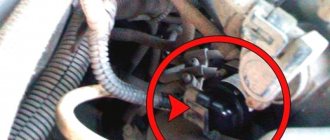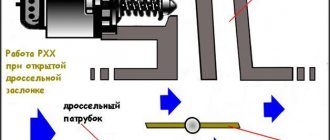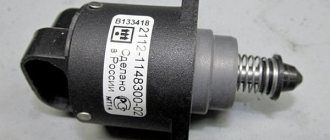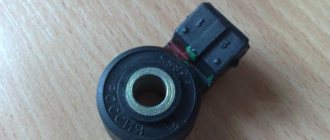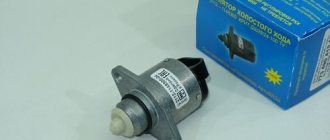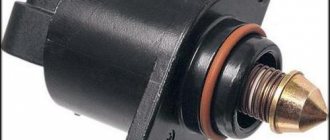A little bit of history
The car of the domestic automobile industry, the VAZ 21099 injector, became quite popular even with the release of the first models from the assembly line.
Its main advantages over its brother, the 6th model in terms of popularity, was the use of front-wheel drive and injection power units. The use of such engines has significantly improved the quality of operation of the unit itself and the power has increased accordingly. This is due to more efficient combustion and preparation of the fuel mixture through the use of injection injection systems. And with an increase in efficiency, the quality of the exhaust gases increased. But, even though the engine has an order of magnitude more sensors than a six-wheel engine, problems with its operation still appear from time to time. They may be related to the following factors:
- poor quality fuel;
- a defect in the unit itself, in the engine or in the injector;
- defects caused by ambient temperature and humidity;
- incorrect adjustment of the fuel injection device.
One of the most typical and frequent malfunctions is instability of the engine, from small fluctuations within 100 revolutions to large jumps, even stopping the engine. This malfunction most often begins to appear at sub-zero temperatures, and especially when moving from plus to minus and at high relative humidity.
In this case, condensation forms in all air ducts and cavities, and when the temperature drops, it turns into ice because it does not have time to dry completely. Which in turn leads to sticking of the rod, both the throttle valve itself and the cone-shaped valve of the idle air control. It is also called the XX sensor.
Operating principle
When the car is moving and the throttle valve is open, the IAC is not involved in the process, its valve is closed and the rod is motionless. When the damper closes and the engine goes into idle mode, voltage is applied to the electric motor and the rod moves towards the opening - the valve comes into operation. It opens slightly, and air enters the engine bypassing through a special hole.
When the driver turns on the ignition, the IAC rod fully extends to its extreme position and closes the calibration hole in the throttle pipe. The sensor then counts the steps and the valve returns to its home position. As for this basic position, it can be different and depends on the firmware installed in the ECU. For January 5.1 firmware the position is 120 steps, for Bosch firmware it is 50 steps.
What is an XX sensor?
The idle speed sensor VAZ 21099 is a small stepper motor enclosed in a metal case. It consists of:
- powder alloy housings along with a stator and multiple windings;
- armatures with permanent magnets;
- rod;
- locking cone-shaped tip;
- springs
- sealing ring.
Idle speed regulator VAZ 21099
The operating principle of a stepper motor is explained based on its design. Since the windings are located not on the armature, but on the stator, then, accordingly, the magnets are no longer on the stator, but on the armature. This placement of the elements makes it possible to obtain from the motor an armature rotation in one pulse at a certain angle, which will depend on the number of windings and, accordingly, poles on the stator.
The simplest stepper motors, for example, an idle speed sensor, have 4 windings and 4 poles. Consequently, when an impulse is applied to one pair, the armature rotates through an angle of 450, when impulses are applied to the second pair, and they are removed from the first, the armature rotates through another 450. And so on.
To control the number of steps taken, the motor must be controlled by a controller or a complex trigger circuit that provides the required number of pulses and at the same time it will count them. Modern stepper motor control devices have been reduced to just one chip, which can do both at the same time. Microcontrollers became such chips.
A microcontroller from Bosch is used as a control device for the idle air regulator for Samara. It is programmed at the factory for use on specific engines, so each engine only has its own XX regulator. And it is not recommended to install it on a more powerful engine, because its operating modes will be different from the necessary ones. Since the operation of the regulator completely depends on the version and type of firmware. There is a plastic connector with 4 contacts on the motor housing for connection to the control unit.
The idle speed sensor is designed to control air flow when the throttle valve is closed, that is, when the gas pedal is released. It determines the stability of idle speed, which ranges from 800 to 1000 rpm. At the same time, he must keep the given frequency at the same level and not vary it.
Checking the serviceability and restoring the functionality of the IAC
Check the functionality of the regulator as follows:
- Connect the battery to the vehicle's on-board network and, holding the IAC in your hands, put the power supply block in place.
- Turn on the ignition. In this case, the regulator rod should retract inward and then extend back to a certain distance. If the IAC acts this way, then it is operational. Otherwise, it must be replaced.
Sometimes the functionality of the regulator is restored after cleaning the spring, valve hole and needle.
Clean the IAC with a cleaner like WD-40. In this case, there is no need to disassemble the device - just treat the rod, needle and spring with a solvent. It also doesn’t hurt to spray the cleaner inside the XX channel, which will clear the valve hole of any contaminants. As soon as the cleaner dries, the functionality of the regulator is checked again and only after that a decision is made on the advisability of replacing it.
IMPORTANT! Before installing a newly purchased or repaired IAC, it is recommended:
Make sure the product matches the vehicle ECU firmware; check functionality; Lubricate the spring and rod with grease.
When choosing an IAC VAZ2109 injector, avoid purchasing counterfeit products. A fake is distinguished by the following characteristics:
- information on the packaging does not allow identifying the manufacturer;
- yellow color of the sticker on the product body;
- dark tip of the locking needle;
- thin sealing ring.
The figure below will help you distinguish the old-style sensor (on the right) from the new-style sensor (on the left):
Where is the XX regulator installed on a VAZ 21099 with an injector?
The auto industry decided not to complicate the task of replacing the XX sensor on different LIM models. For example, VAZ 21214 and 21074 cars have almost the same arrangement of organs as on 21099. The sensor is located on the left at the top of the engine when looking at the car from the front, facing the engine, and is attached to the throttle body. It can be fastened with two screws, or it can simply be glued with glue. The sensor, with its cone-shaped rod, is installed in a hole on the throttle body and, with its cone, blocks the air duct into the throttle chamber.
The idle speed regulator of the VAZ 21099 is located on the throttle valve
Visual inspection and cleaning of the idle air regulator and valve
Step 1: Valve Access . For information about the position of the IAC valve on your vehicle, refer to your vehicle's service manual.
Step 2: Disconnect the valve . Locate the valve's electrical connection and disconnect the idle air valve.
Step 3: Remove the valve from the car . Use the procedure described in your vehicle's service manual to remove the valve.
Step 4: Check the idle air valve . Inspect the valve and mounting location for carbon deposits, rust, or dirt. Check the valve pin and mounting location for damage.
Step 5: Clean the valve and bypass . Use carbon cleaner or intake cleaner solvent to remove debris and dirt from the valve. Use the straw provided with the aerosol can to clean the valve area and bypass.
Warning . Do not use metal wire brushes to clean the valve or bypass circuit. Cleaning the walls or pegs with a wire brush may change the function of the valve.
XX regulation principle
The XX sensor should be called a regulator because it doesn't control anything. But everyone is accustomed to simply calling the entire control circuit assembly a regulator.
Structural scheme
Structurally, the controller circuit can be divided into several functional blocks that perform specific operations:
- controlled;
- manager;
- controlling.
The controlled unit turns on the sensor-motor itself, it opens and closes the air channel.
Sequence of operation of all blocks
The control block is the control circuit. A microcontroller is installed in it, which issues control pulses to the sensor, while controlling the rotation speed. This is carried out by the crankshaft sensor VAZ 21099 injector. Then the controller processes the data received from it and, if necessary, issues the next sequence of pulses.
At the initial moment, when the engine is still cold and not started, the shut-off rod of the XX sensor completely blocks the air duct. And the controller does not produce any pulses. When you turn the key and start the engine, the control unit reads the speed readings from the crankshaft sensor. Since it turns out that there is already rotation, but the valve is not yet open, the controller issues the first impulses to open the air duct. At the same time, it also controls the amount of air consumed using a corresponding sensor.
Then the data from the crankshaft sensor is again read by the controller and it turns out that the speed is lower than required. Then the controller issues the next pulse to the XX sensor, which, having turned another angle, opens the channel more, thereby enriching the mixture better. Consequently, this leads to an increase in the crankshaft speed. When the auxiliary mechanisms reach the set frequency, the controller stops sending pulses to the engine.
With a floating engine speed of a VAZ 21099 car, the injector idle speed sensor most likely has failed, but there may also be a malfunction in the control unit.
Since the diagnostic system of the machine itself is not able to determine the malfunction of the XX sensor, complex measures have to be used. Replace the sensor if replacing the control unit does not help. If the engine roars at full power, but there are no revolutions on the tachometer, then the crankshaft rotation sensor will already be faulty.
Installation of a new IAC
Installation of the new device on the VAZ 2109 and 21099 is carried out in the reverse order: connect the wires, put them in place, and fix them with two bolts. But sometimes situations occur when, after replacement, the engine speed still fluctuates and no changes occur. So, in order to avoid such a nuisance, before installation, you should definitely check the new part.
To do this, connect the disconnected sensor to a multimeter. The positive wire goes to the coil, and the negative wire goes to the motor. Next, turn on the ignition and check the instrument readings. If they float around 12 V, then the device is working properly and is ready for use. But if the instrument scale readings show 0 V, then the part is definitely faulty.
If, during the same check, the old, broken sensor also shows 12 V, but at the same time, the engine speed fluctuates during its operation, then the old device is working properly and needs cleaning.
The process of cleaning this part includes complete disassembly. Therefore, it is better to entrust this matter to a specialist, since carrying out the cleaning procedure yourself can completely break the device.
